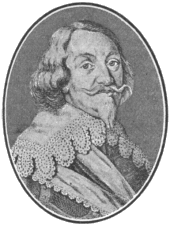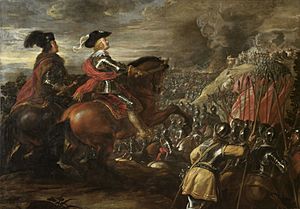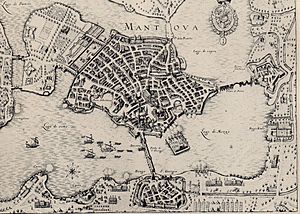Matthias Gallas facts for kids
Quick facts for kids
Matthias Gallas
|
|
|---|---|

Matthias Gallas, Graf von Campo, Herzog von Lucera
|
|
| Born | 17 October 1588 Trento, Prince-Bishopric of Trent |
| Died | 25 April 1647 (aged 58) Vienna, Austria |
| Allegiance | |
| Rank | Generalfeldmarschall |
| Battles/wars | War of the Mantuan Succession
|
| Spouse(s) | Isabella of Arco († 1632), Dorothea Anna von Lodron († 1666) |
| Signature | |
Matthias Gallas (born October 17, 1588, in Trento – died April 25, 1647, in Vienna) was an important Austrian military leader during the Thirty Years' War. He was known as the Count of Campo and Duke of Lucera.
Gallas first became famous serving the Catholic League and later as one of Albrecht von Wallenstein's main generals. After helping to remove Wallenstein from power, Gallas became the top commander of the Imperial Army three times between 1634 and 1647.
He played a key role in the big victory at the Battle of Nördlingen in 1634. However, his later military actions were not as successful. He struggled with attacks against France and had trouble stopping Swedish forces. He often faced problems with supplies and his armies became smaller. Because of these difficulties, he lost his command more than once. Gallas suffered from poor health for many years and died in 1647.
Contents
Matthias Gallas's Early Military Career
Gallas began his military journey as a page and then a cavalryman for Ferdinando Madruzzo. He likely fought as a Spanish soldier in Flanders. Later, he served Spain as an officer against the Savoy. In 1616, Gallas took part in the Spanish siege of Vercelli in Piedmont.
After Giannangelo Madruzzo died in 1618, Gallas became the commander of the Riva fortress. He was a Captain there until 1621. In that year, Gallas joined the Catholic League and entered the Thirty Years' War. He was a commander of an infantry regiment and showed great skill, especially at the Battle of Stadtlohn in 1623.
He was promoted to colonel in 1625. However, the Bavarian Elector Maximilian did not want to promote him further. So, Gallas decided to join the Imperial army in 1629.
From 1629, Gallas served as a general under Count Collalto in the War of the Mantuan Succession. When Collalto became sick, Gallas took over command of the Imperial army with Johann von Aldringen.
On May 29, 1630, Gallas won a major victory at the battle of Villabuona. He defeated a large French-Venetian army. This win helped the Imperial troops capture Mantua on July 18. The city was then brutally looted. Gallas stayed in Italy to help negotiate the Treaty of Cherasco. This treaty allowed the Valtellina region to remain under Imperial control.
Becoming a Top Commander
After capturing Mantua, Gallas was made an Imperial Count. He returned to Germany in late 1631 to fight against the Swedish king Gustavus Adolphus. Gallas was promoted to Feldzeugmeister (a high military rank) and led a part of Wallenstein's army. He helped retake parts of Bohemia from the Saxons.
In 1632, Gallas's troops fought at the Battle of the Alte Veste near Nuremberg against the Swedish King. After this battle, Gallas was promoted to Field Marshal. Wallenstein sent him away before the Battle of Lützen, so Gallas did not arrive in time to fight. Emperor Ferdinand II then made Gallas Generalleutnant, which meant he was second-in-command to Wallenstein. Gallas commanded in Silesia during 1633.
Wallenstein began to disobey the Emperor and negotiate on his own. The Emperor's advisors became suspicious. They contacted Gallas to check his loyalty and told him about plans to remove Wallenstein. Gallas tried to convince Wallenstein to change his ways, but he failed.
When Gallas learned that the Emperor wanted Wallenstein arrested or killed, he left the army's headquarters on February 12, 1634. He made sure the troops remained loyal to the Emperor. Wallenstein fled and was later killed. Gallas was rewarded with a large part of Wallenstein's former lands.
Leading the Imperial Army

In the next campaign, Gallas was the real commander, advising the Emperor's son, Ferdinand of Hungary, who was new to leading an army. Their goal was to retake Regensburg and meet up with a Spanish army. The Imperial forces captured Regensburg on July 26, followed by Donauwörth on August 16.
They then began to besiege Nördlingen. A Spanish army joined them there. On September 5, a smaller Swedish army tried to stop the siege. But Gallas led the combined Habsburg army to a huge victory at the Battle of Nördlingen. The Swedes lost two armies and control over southern Germany. The Imperial forces chased them before settling into winter camps.
In 1635, the Imperials turned their attention to the Rhine river. After France openly joined the war, Gallas and his troops crossed the river. He captured most of the Palatinate, including Kaiserslautern and Worms. He then started to besiege Mainz. When French and Weimar forces approached, Gallas pulled back. He used his cavalry to bother them and cut off their supplies. This worked well, and many French soldiers died from sickness or hunger. The siege of Mainz was finished successfully in December.
In 1636, Gallas was ordered to invade Burgundy to support Spain. He gathered his troops and marched into the Franche-Comté. French troops were besieging Dole, the capital. Gallas sent his advance troops, who helped relieve Dole in August. His main army camped at Champlitte, facing a French army. Gallas did not want to attack directly. After several weeks, he moved towards Dijon. He captured a castle but was hesitant to go further. He decided to besiege Saint-Jean-de-Losne to secure a bridge for supplies or retreat. However, the small town resisted. French reinforcements and heavy rain forced Gallas to give up the siege and the invasion in November.
Challenges and Later Campaigns
In 1637, Gallas was sent to northern Germany. He was more successful at stopping the Swedish general Johan Banér. He almost surrounded the Swedes at Torgau but Banér managed to escape. Gallas chased him into Pomerania and blocked his path. Banér tricked the Imperials and moved his troops across the Oder river. Gallas then trapped him along the coastline, taking most strongholds except for very fortified ones like Stralsund. The Swedes seemed ready for peace, but their Chancellor used the offers to get more help from France.
During 1638, Gallas's situation got much worse. Banér received fresh troops, but Gallas got little support from his allies. In October 1638, Banér broke through Gallas's defenses. The Imperial army could no longer find enough supplies in the damaged area. They retreated, losing many soldiers along the way. After Gallas's retreat, Banér pushed into Saxony and then into Bohemia in May 1639. Gallas tried to defend Prague from Swedish attacks. But his army's morale was low, and he was replaced by Archduke Leopold Wilhelm of Austria in September. Gallas chose to return home to Trento for a few years.
Return to Command and Final Years
In March 1643, Gallas was called back to lead the army again. He tried to block the Swedish general Lennart Torstensson from marching into Moravia. Gallas took a strong defensive position. Instead of fighting a big battle, Gallas used his cavalry to harass the Swedes. At the end of the year, the Swedes surprisingly left to attack Denmark in what became the Torstenson War.
In 1644, Gallas was ordered to help Denmark in Holstein. He was doubtful about this mission and delayed his departure. He slowly moved to Kiel, which he recaptured from Sweden in August. Torstensson was already in control of Jutland. He bypassed Gallas's army and threatened their supply lines. Gallas had to retreat to Bernburg, where Torstensson's cavalry surrounded the Imperial troops and cut off their supplies. Gallas managed to escape to Magdeburg in November, but the same thing happened there. His army was greatly reduced by hunger, sickness, and soldiers leaving. Gallas himself became ill. He ordered his remaining troops to break out. Most of his cavalry was caught, and only a small part of his infantry reached Bohemia in February 1645.
Gallas stayed with the sick soldiers in Magdeburg and returned to Prague in late February. His command was given to Melchior von Hatzfeldt. Gallas, slightly recovered, was called back to help the new Generalissimo, Leopold Wilhelm. He gathered the scattered Imperial troops in Bohemia and organized the defense. When Gallas's health worsened and his relationship with the Archduke declined, he left his position again at the end of the year.
Feeling a bit better, Gallas was asked to replace the Archduke as supreme commander in December 1646. He agreed, even though he thought someone else would be better. Soon, he was sick again with gout and fever. He was too ill to lead another campaign. He focused on keeping the Imperial army together through the winter. Gallas could not stop the Bavarian Elector from signing a truce with France and Sweden in March 1647. He even agreed that it was the right thing to do. The Emperor called Gallas back to Vienna in late March. His command was given to Count Holzappel on April 17. Gallas died eight days later after a surgery failed.
Gallas's Military Style
Gallas's early successes were not matched by his achievements after 1634. He was a general who never lost a major battle after Nördlingen because he avoided big, risky fights. However, he could not stop his armies from being ruined in various campaigns due to a lack of supplies. He often complained about the difficult conditions but always followed the Emperor's orders. After his very difficult campaigns in 1638 and 1644, he became known as the "destroyer of armies." This nickname came from French and Swedish propaganda but stuck with him.
Historians say Gallas was a clever tactician, especially good at defending. But he often lacked the strong will and risk-taking needed for attacks. He was good at planning his campaigns but struggled more and more with carrying them out as the Thirty Years' War became harder. Gallas was not one of the commanders who could easily adjust to these changing and tough conditions.
Family Life
Gallas first married Isabella of Arco in 1630. After she died in 1632, he married Dorothea Anna von Lodron two years later. They had at least seven children. Four of them survived childhood: Franz Ferdinand (1635–1697), Theresia Annunziata Francesca († 1667), Anton Pankraz (1638–1695), and Maria Viktoria (1639–1687). His most famous descendant was his grandson, Johann Wenzel von Gallas (1669–1719), who was a diplomat and Austrian ruler of Naples.
After the last male Gallas died in 1757, the family name changed to Clam-Gallas. This family later provided many respected soldiers to the Imperial army.
Gallas's Possessions
Even though he was called Count of Campo, Gallas never owned the actual Castle Campo. His family had lost it many generations before. From his pay as a soldier, he bought his first pieces of land before 1621. He also bought a house in Trento in 1623 and a mansion in Mattarello in 1628. In 1632 or 1642, he bought the Palazzo Fugger in Trento, which then became known as Palazzo Galasso.
Because he was loyal to the Habsburgs during Wallenstein's removal in 1634, Gallas received most of Wallenstein's property in the Bohemian Duchy of Friedland. This included Frýdlant and Liberec. He also received the Smiřice dominion. In northern Italy, he bought Castle Freyenthurn and most of the surrounding village between 1634 and 1636.
On August 22, 1635, King Philip IV of Spain made Gallas the Duke of Lucera. This title was connected to land in the Kingdom of Naples. However, Gallas himself did not use this title in his documents or letters.
See also
 In Spanish: Matthias Gallas para niños
In Spanish: Matthias Gallas para niños





